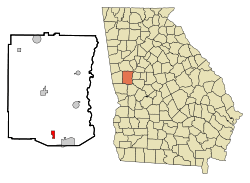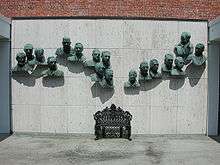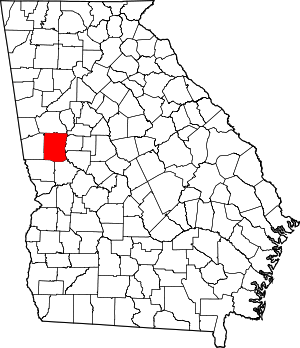Warm Springs, Georgia
Warm Springs is a city in Meriwether County, Georgia, United States. The population was 425 at the 2010 census.
Warm Springs, Georgia | |
|---|---|
City | |
Broad Street in Warm Springs. | |
 Location in Meriwether County and the state of Georgia | |
 Warm Springs Location of Warm Springs in Georgia and in the US  Warm Springs Warm Springs (the United States) | |
| Coordinates: 32°53′19″N 84°40′48″W | |
| Country | |
| State | |
| County | Meriwether |
| Area | |
| • Total | 1.53 sq mi (3.98 km2) |
| • Land | 1.50 sq mi (3.89 km2) |
| • Water | 0.03 sq mi (0.09 km2) |
| Elevation | 930 ft (280 m) |
| Population (2010) | |
| • Total | 425 |
| • Estimate (2018)[2] | 404 |
| • Density | 269.15/sq mi (103.93/km2) |
| Time zone | UTC-5 (Eastern (EST)) |
| • Summer (DST) | UTC-4 (EDT) |
| ZIP code | 31830 |
| Area code(s) | 706 |
| FIPS code | 13-80480[3] |
| GNIS feature ID | 0324851[4] |
History
Warm Springs, originally named Bullochville (after the Bulloch family, the family of Martha Bulloch Roosevelt), first came to prominence in the 19th century as a spa town, because of its mineral springs which flow constantly at nearly 90 °F (32 °C). Residents of Georgia, particularly Savannah, began spending vacations at Bullochville in the late 18th century as a way to escape yellow fever, finding the number of warm springs in the vicinity of Bullochville very attractive. In the late 19th century traveling to the warm springs was attractive as a way to get away from Atlanta. Traveling by railroad to Durand, they would then go to Bullochville. One of the places benefiting from this was the Meriwether Inn. Once the automobile became popular in the early 20th century, the tourists began going elsewhere, starting the decline of the Meriwether Inn.[5][6]
In 1921, Franklin Roosevelt contracted a paralytic illness, diagnosed at the time as poliomyelitis (later thought in a 2003 peer-reviewed retrospective study to be Guillain–Barré syndrome[7]). He tried to regain strength in his legs by bathing and exercising in the warm water. His first time in Warm Springs was October 1924. He went to a resort in the town whose attraction was a permanent 88-degree natural spring, but the Meriwether Inn was described as "ramshackle". He had a cottage built in 1932 that became famous as the Little White House, where Roosevelt lived while president, because of his paralytic illness. He died there in 1945 and it is now a public museum. Roosevelt first came in the 1920s in hopes that the warm water would improve his paraplegia. He was a constant visitor for two decades, and renamed the town from Bullochville to Warm Springs. The town is still home to the Roosevelt Warm Springs Institute for Rehabilitation (Roosevelt's former polio hospital) which remains a world-renowned comprehensive rehabilitation center including a physical rehabilitation hospital and vocational rehabilitation unit. Thomas M. Humphrey was one of the children treated for polio at the Institute during the 1940s. The springs are not available for public use as a bath/spa resort, but they are used by the Roosevelt Institute for therapeutic purposes.
Geography
Warm Springs is located at 32°53′19″N 84°40′48″W (32.888689, −84.680089).[8]
According to the United States Census Bureau, the city has a total area of 1.2 square miles (3.1 km2), of which 1.2 square miles (3.1 km2) is land and 0.83% is water.
Demographics
| Historical population | |||
|---|---|---|---|
| Census | Pop. | %± | |
| 1910 | 204 | — | |
| 1920 | 332 | 62.7% | |
| 1930 | 400 | 20.5% | |
| 1940 | 608 | 52.0% | |
| 1950 | 557 | −8.4% | |
| 1960 | 538 | −3.4% | |
| 1970 | 523 | −2.8% | |
| 1980 | 461 | −11.9% | |
| 1990 | 407 | −11.7% | |
| 2000 | 485 | 19.2% | |
| 2010 | 425 | −12.4% | |
| Est. 2018 | 404 | [2] | −4.9% |
| U.S. Decennial Census[9] | |||
As of the census[3] of 2010, there were 485 people, 172 households, and 107 families residing in the city. The population density was 409.7 people per square mile (158.7/km2). There were 208 housing units at an average density of 175.7 per square mile (68.1/km2). The racial makeup of the city was 67.22% White, 31.75% African American, and 1.03% from two or more races.
There were 172 households out of which 26.9% had children under the age of 18 living with them, 34.3% were married couples living together, 25.1% had a female householder with no husband present, and 36.6% were non-families. 34.3% of all households were made up of individuals and 16.0% had someone living alone who was 65 years of age or older. The average household size was 2.33 and the average family size was 2.99.
In the city, the population was spread out with 21.2% under the age of 18, 7.4% from 18 to 24, 22.1% from 25 to 44, 20.6% from 45 to 64, and 28.7% who were 65 years of age or older. The median age was 45 years. For every 100 females, there were 62.8 males. For every 100 females age 18 and over, there were 57.2 males.
The median income for a household in the city was $21,547, and the median income for a family was $29,950. Males had a median income of $24,422 versus $13,110 for females. The per capita income for the city was $14,872. About 14.7% of families and 16.4% of the population were below the poverty line, including 21.7% of those under age 18 and 9.3% of those age 65 or over.
Notable people
- US President Franklin Delano Roosevelt lived in the Little White House in Warm Springs while he was not in Washington or at his residence in Hyde Park, New York. He also died there.
- Philanthropist George Foster Peabody retired in Warm Springs, Georgia
- After graduating from John H. Francis Polytechnic High School, Cosmopolitan Magazine Editor Helen Gurley Brown and her family moved to Warm Springs.[10]
- George W. Jenkins, founder of Publix, was born in Warm Springs.
- Cpl. Maoma L. Ridings was from Warm Springs. Cpl. Ridings was a WAC stationed at Camp Atterbury, was murdered August 28, 1943, in Room 729 of the Claypool Hotel in Downtown Indianapolis. Her murder was never solved[11] and made national news because she'd once been a nurse to President Roosevelt on his visits to Warm Springs.[12]
Gallery
 The Little White House, located in the Warm Springs Historic District, was Franklin Delano Roosevelt's personal retreat and was the site of his death. The house was opened to the public as a museum in 1948.
The Little White House, located in the Warm Springs Historic District, was Franklin Delano Roosevelt's personal retreat and was the site of his death. The house was opened to the public as a museum in 1948.- Georgia Hall, the main building of the Roosevelt Warm Springs Institute, was built in 1933. Franklin D. Roosevelt often hosted Thanksgiving dinners in its dining hall for those who were using the Springs. For much of its existence, the institute was the only such facility "exclusively devoted" to polio patients.
 The Polio Hall of Fame (or the Polio Wall of Fame) consists of a linear grouping of sculptured busts of fifteen scientists and two laymen who made important contributions to the knowledge and treatment of poliomyelitis. It is found on the outside wall of what is called Founder's Hall of the Roosevelt Warm Springs Institute for Rehabilitation in Warm Springs, Georgia.
The Polio Hall of Fame (or the Polio Wall of Fame) consists of a linear grouping of sculptured busts of fifteen scientists and two laymen who made important contributions to the knowledge and treatment of poliomyelitis. It is found on the outside wall of what is called Founder's Hall of the Roosevelt Warm Springs Institute for Rehabilitation in Warm Springs, Georgia.- The Eleanor Roosevelt School in Warm Springs was built in 1936. It was the last school built in the United States using funds provided by the Julius Rosenwald Fund. The school operated from 1937 until 1972. The building was purchased privately in 1977. It was added to the National Register of Historic Places on May 3, 2010.
- The Benjamin F. Bulloch House was built in the Queen Anne style in 1893 by Warm Springs' co-founder, Benjamin F. Bulloch. It was added to the National Register of Historic Places on May 26, 1994. For many years, the house was the location of "The Bulloch House Restaurant". The Benjamin F. Bulloch House was completely destroyed by a fire on June 10, 2015.
- The Bulloch Family House is located at 5634 Spring St. It was added to the National Register of Historic Places on January 11, 2002.
- The Oakland Plantation Inn was built in 1829. It was added to the National Register of Historic Places on June 28, 1982.
- Warm Springs was originally named "Bullochville". The historic district of Old Bullochville is located in the center of town and is the site of the annual Watermelon Festival.
- Downtown Warm Springs.
References
- "2018 U.S. Gazetteer Files". United States Census Bureau. Retrieved February 12, 2020.
- "Population and Housing Unit Estimates". Retrieved June 4, 2019.
- "U.S. Census website". United States Census Bureau. Retrieved January 31, 2008.
- "US Board on Geographic Names". United States Geological Survey. October 25, 2007. Retrieved January 31, 2008.
- Georgia State Parks – History
- Warm Springs Historic District NRHP nomination form
- Goldman AS, Schmalstieg EJ, Freeman DH, Goldman DA, Schmalstieg FC (2003). "What was the cause of Franklin Delano Roosevelt's paralytic illness?" (PDF). Journal of Medical Biography. 11 (4): 232–40. PMID 14562158. Retrieved July 4, 2017.
- "US Gazetteer files: 2010, 2000, and 1990". United States Census Bureau. February 12, 2011. Retrieved April 23, 2011.
- "Census of Population and Housing". Census.gov. Retrieved June 4, 2015.
- Scanlon, Jennifer (2009). Toff, Nancy (ed.). Bad Girls Go Everywhere: The Life of Helen Gurley Brown. Oxford University Press. p. 17. ISBN 978-0-19-534205-5.
- "'The WAC Murder' still unsolved 70 years later". Indianapolis Star. Retrieved October 23, 2013.
- Waters, Robert. "10 Brutal Murders on the Home Front during World War II". Retrieved October 23, 2013.
Relevant literature
- Harmon, Martin. 2014 The Warm Springs Story: Legacy and Legend. Macon, GA: Mercer University Press.
